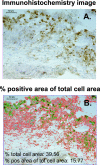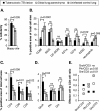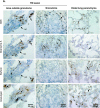Impaired expression of perforin and granulysin in CD8+ T cells at the site of infection in human chronic pulmonary tuberculosis
- PMID: 17664265
- PMCID: PMC2168267
- DOI: 10.1128/IAI.00624-07
Impaired expression of perforin and granulysin in CD8+ T cells at the site of infection in human chronic pulmonary tuberculosis
Abstract
Protective immunity in tuberculosis is dependent on the coordinated release of cytolytic effector molecules from effector T cells and the subsequent granule-associated killing of infected target cells. In this study, we investigated the expression of cytolytic (perforin and granzyme A) and antimicrobial (granulysin) molecules at the single-cell level in cryopreserved lung tissue from patients with chronic, progressive tuberculosis disease. Quantification of protein-expressing cells was performed by in situ imaging, while mRNA levels in the infected tissue were analyzed by real-time PCR. Persistent inflammation, including excessive expression of inducible nitric oxide synthase in CD68+ macrophages and significant infiltration of CD3+, CD8+ and CD4+ T cells, was evident in tuberculosis lesions in all patients. However, despite the accumulation of CD3+ T cells, perforin- and granulysin-expressing CD3+ T cells were detected at two- to threefold-lower ratios in the tuberculosis lesions than in distal lung parenchyma and uninfected control lungs, respectively. This was evident at both the protein and mRNA levels. Moreover, perforin- and granulysin-expressing CD8+ T cells were scarce in individual granulomas within the tuberculosis lesions. In contrast, significant up-regulation of granzyme A-expressing CD3+ T cells was evident in the lesions from all patients. Confocal microscopy revealed coexpression of perforin and granulysin, primarily in CD8+ T cells; however, this expression was lower in the tuberculosis lesions. These findings suggest that symptomatic, chronic tuberculosis disease is associated with insufficient up-regulation of perforin and granulysin coexpression in CD8+ T cells at the local site of infection.
Figures






Similar articles
-
Single-cell perforin and granzyme expression reveals the anatomical localization of effector CD8+ T cells in influenza virus-infected mice.Proc Natl Acad Sci U S A. 2003 Mar 4;100(5):2657-62. doi: 10.1073/pnas.0538056100. Epub 2003 Feb 24. Proc Natl Acad Sci U S A. 2003. PMID: 12601154 Free PMC article.
-
Coordinate expression of CC chemokine ligand 5, granulysin, and perforin in CD8+ T cells provides a host defense mechanism against Mycobacterium tuberculosis.J Immunol. 2005 Dec 1;175(11):7474-83. doi: 10.4049/jimmunol.175.11.7474. J Immunol. 2005. PMID: 16301655
-
Human decidual tissue contains differentiated CD8+ effector-memory T cells with unique properties.J Immunol. 2010 Oct 1;185(7):4470-7. doi: 10.4049/jimmunol.0903597. Epub 2010 Sep 3. J Immunol. 2010. PMID: 20817873
-
Cytolytic T cells in the immune response to mycobacterium tuberculosis.Scand J Infect Dis. 2001;33(7):483-7. doi: 10.1080/00365540110026584. Scand J Infect Dis. 2001. PMID: 11515755 Review.
-
A Review of the Pathogenesis of Toxic Epidermal Necrolysis.J Nippon Med Sch. 2016;83(6):216-222. doi: 10.1272/jnms.83.216. J Nippon Med Sch. 2016. PMID: 28133001 Review.
Cited by
-
Diagnostic performance of culture filtered protein 10-specific perforin in pediatric patients with active tuberculosis.J Clin Lab Anal. 2020 Nov;34(11):e23477. doi: 10.1002/jcla.23477. Epub 2020 Jul 16. J Clin Lab Anal. 2020. PMID: 32671908 Free PMC article.
-
Transcriptional Profiling of Early and Late Phases of Bovine Tuberculosis.Infect Immun. 2022 Feb 17;90(2):e0031321. doi: 10.1128/IAI.00313-21. Epub 2021 Dec 13. Infect Immun. 2022. PMID: 34898250 Free PMC article.
-
Induction of granulysin and perforin cytolytic mediator expression in 10-week-old infants vaccinated with BCG at birth.Clin Dev Immunol. 2011;2011:438463. doi: 10.1155/2011/438463. Epub 2010 Dec 28. Clin Dev Immunol. 2011. PMID: 21234358 Free PMC article.
-
Immunosuppressive Features of the Microenvironment in Lymph Nodes Granulomas from Tuberculosis and HIV-Co-Infected Patients.Am J Pathol. 2022 Apr;192(4):653-670. doi: 10.1016/j.ajpath.2021.12.013. Epub 2022 Jan 31. Am J Pathol. 2022. PMID: 35092727 Free PMC article.
-
Polarization of Human Monocyte-Derived Cells With Vitamin D Promotes Control of Mycobacterium tuberculosis Infection.Front Immunol. 2020 Jan 22;10:3157. doi: 10.3389/fimmu.2019.03157. eCollection 2019. Front Immunol. 2020. PMID: 32038652 Free PMC article.
References
-
- Andersson, J., H. Behbahani, J. Lieberman, E. Connick, A. Landay, B. Patterson, A. Sonnerborg, K. Lore, S. Uccini, and T. E. Fehniger. 1999. Perforin is not co-expressed with granzyme A within cytotoxic granules in CD8 T lymphocytes present in lymphoid tissue during chronic HIV infection. AIDS (London) 13:1295-1303. - PubMed
-
- Andersson, J., A. Boasso, J. Nilsson, R. Zhang, N. J. Shire, S. Lindback, G. M. Shearer, and C. A. Chougnet. 2005. The prevalence of regulatory T cells in lymphoid tissue is correlated with viral load in HIV-infected patients. J. Immunol. 174:3143-3147. - PubMed
-
- Andersson, J., S. Kinloch, A. Sonnerborg, J. Nilsson, T. E. Fehniger, A. L. Spetz, H. Behbahani, L. E. Goh, H. McDade, B. Gazzard, H. Stellbrink, D. Cooper, and L. Perrin. 2002. Low levels of perforin expression in CD8+ T lymphocyte granules in lymphoid tissue during acute human immunodeficiency virus type 1 infection. J. Infect. Dis. 185:1355-1358. - PubMed
Publication types
MeSH terms
Substances
LinkOut - more resources
Full Text Sources
Other Literature Sources
Research Materials

